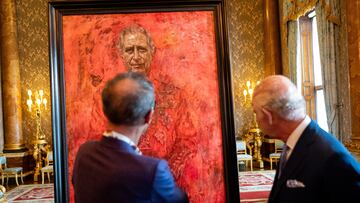Why is King Charles III’s portrait red? And why does he have a butterfly over his shoulder?
Jonathan Yeo while keeping some features of royal portraits with his painting of King Charles III injected “a dynamic, contemporary jolt into the genre.”

Jonathan Yeo, the artist who painted the first official portrait of King Charles III since his coronation, says that he “wanted to minimise the visual distractions and allow people to connect with the human being underneath,” in his striking, larger-than-life work. The eight-plus-feet tall portrait stands out from more traditional royal depictions via its uniform use of vivid red hues throughout the canvas with the exception of the monarch’s hands and more importantly his face.
“I do my best to capture the life experiences etched into any individual sitter’s face,” Yeo explained in a statement. “Above all else, to communicate the subject’s deep humanity.”
Likewise, he added a monarch butterfly, which is thought to have been named after an earlier English king, William of Orange, fluttering toward the king’s shoulder to add “a layer of narrative depth.”

Why is King Charles III’s portrait red? And why does he have a butterfly over his shoulder?
The portrait of King Charles III depicts the monarch in the bright red uniform of the Welsh Guards, of which he was made Regimental Colonel in 1975. In the background vibrant hues of the same color “echo the uniform’s bright red tunic.”
This was done to resonate with the royal heritage of prior historical portraits while at the same time “injecting a dynamic, contemporary jolt into the genre with its uniformly powerful hue” and thus “providing a modern contrast to more traditional depictions,” according to the artist.
The butterfly for its part symbolizes both the “known advocacy for environmental causes” of King Charles III and “his personal transformation” into His Majesty. Yeo had begun the portrait while the current monarch was still the Prince of Wales.
“In the context of art history, a butterfly often the symbol of metamorphosis and rebirth, and thus also parallels the King’s transition from Prince to monarch during the period the portrait was created,” Yeo states.
“Primarily a symbol of the beauty and precariousness of nature, it highlights the environmental causes the King has championed most of his life and certainly long before they became a mainstream conversation,” the artist explains.
At the same time, “it also serves a compositional purpose, providing a visual contrast to the military steeliness of the uniform and sword,” he added.
